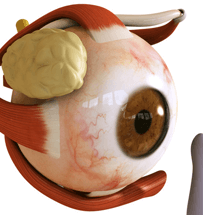

(Chandrashekhar Keratoconus Retardation Treatment - CKRT)
Chandrashkehra Chawan has invented a treatment called CKRT to retard the optical irregularities of keratoconic cornea permanently with his specially designed fenestrated sclera lenses and specially formulated eye drops, that reshapes the central 5 to 7 mm of cornea permanently without any surgery to reduce high order aberrations and give normal vision without any correction once the treatment period is over.
Treatment period may last from 6 months to 2 years depending on the age of Keratoconus, age of patient, corneal thickens, corneal elasticity, family history, genetic factors etc.
For more information contact: shekhar@shekhareye.com
visit: Shekhar Eye
107 Falcon Court,
Hari Om Nagar,
Mulund (E),
Mumbai 400081.
www.shekhareye.com
What is Keratoconus?
Keratoconus often appears in the teens or early twenties, it’s a progressive disease in which the normally round cornea thins and begins to bulge into a cone-like shape. This cone shape deflects light as it enters the eye on its way to the light-sensitive retina, causing distorted vision. Keratoconus can occur in one or both eyes.
Signs and Symptoms of Keratoconus are:
- Astigmatism
- Eye rubbing
- Nearsightedness
- Ghost images
- Glare at night
- Light sensitivity
- Blurred vision even when wearing glasses and contact lenses
- Frequent prescription changes in glasses and contact lenses
Causes for Keratoconus:
 New research has demonstrated a relationship between malfunction of beneficial enzymes found within the eye’s surface and an accompanying chemical imbalance that leads to toxic damage and thinning of eye tissue. Because keratoconus can be found in extended families, this improper functioning of beneficial enzymes appears to have genetic causes about 5% of the time. Eye damage from keratoconus also can be linked to factors such as overexposure to sunlight, improper fittings of contact lenses, excessive eye rubbing, and continual (chronic) eye irritation.
New research has demonstrated a relationship between malfunction of beneficial enzymes found within the eye’s surface and an accompanying chemical imbalance that leads to toxic damage and thinning of eye tissue. Because keratoconus can be found in extended families, this improper functioning of beneficial enzymes appears to have genetic causes about 5% of the time. Eye damage from keratoconus also can be linked to factors such as overexposure to sunlight, improper fittings of contact lenses, excessive eye rubbing, and continual (chronic) eye irritation.
How Keratoconus Is Detected and Diagnosed?
Keratoconus is usually diagnosed when patients reach their 20’s. For some, it may advance over several decades, for others, the progression may reach a certain point and stop. Keratoconus is not usually visible to the naked eye until the later stages of the disease. In severe cases, the cone shape is visible to an observer when the patient looks down while the upper lid is lifted. When looking down, the lower lid is no longer shaped like an arc, but bows outward around the pointed cornea. This is called Munson’s sign.
Special corneal testing called topography provides the doctor with detail about the cornea’s shape and is used to detect and monitor the progression of the disease. A pachymeter may also be used to measure the thickness of the cornea.
Treatment for Keratoconus:
 The first line of treatment for patients with keratoconus is to fit rigid gas permeable (RGP) contact lenses. Because this type of contact is not flexible, it creates a smooth, evenly shaped surface to see through. However, because of the cornea’s irregular shape, these lenses can be very challenging to fit. This process often requires a great deal of time and patience. When vision deteriorates to the point that contact lenses no longer provide satisfactory vision, corneal transplant may be necessary to replace the diseased cornea with a healthy one.
The first line of treatment for patients with keratoconus is to fit rigid gas permeable (RGP) contact lenses. Because this type of contact is not flexible, it creates a smooth, evenly shaped surface to see through. However, because of the cornea’s irregular shape, these lenses can be very challenging to fit. This process often requires a great deal of time and patience. When vision deteriorates to the point that contact lenses no longer provide satisfactory vision, corneal transplant may be necessary to replace the diseased cornea with a healthy one.
Surgical options like CXL, DALK, IC and patial thickness keratoplasty or penetrating keratoplasty are some options with lot of complications and multiple follow up visits to ophthalmologist, also even after this surgical treatment patients has to use specialty contact lenses.
There are hybrid lenses and other verity of lenses available for vision improvement with compromise in comfort or vision.
Scleral lenses is the best option for vision restoration in patients with Keratoconus.
 OUR SPECIALIST
OUR SPECIALIST
 our products
our products

- 3D Custom Made Artificial Eyes
- Keratoconus
- Oculoplasty
- Orthokeratology
- Speciality Contact Lens
- Chandra Scleral Lenses
- Myopia Control
- Gold Contact Lenses
 phone
phone
 email
email

 buy online
buy online
.jpg)
.jpg)






